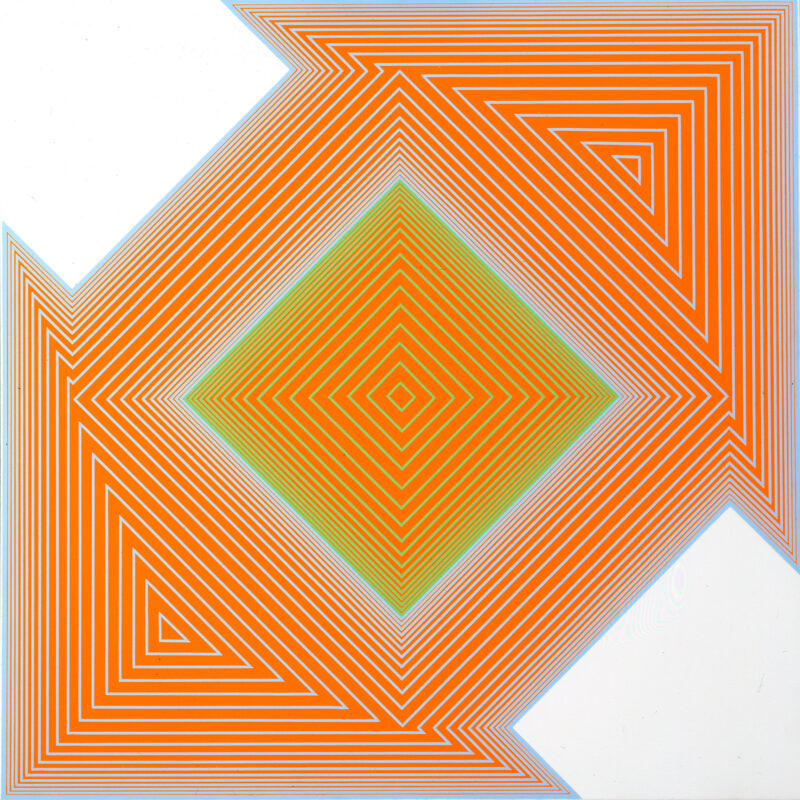
WAM 77
Anuszkiewicz, Richard
1977
Artwork Information
-
Title:
WAM 77
-
Artist:
Anuszkiewicz, Richard
-
Artist Bio:
American, 1930–2020
-
Date:
1977
-
Medium:
Acrylic on canvas
-
Dimensions:
40 1/4 x 40 1/4 inches
-
Credit Line:
Wichita Art Museum, Museum purchase, Friends of the Wichita Art Museum
-
Object Number:
1977.91
-
Display:
Not Currently on Display
About the Artwork
WAM ’77 is an acrylic on canvas executed by the American artist Richard Anuszkiewicz and commissioned by the Wichita Art Museum to commemorate the completion and public opening of the new Museum building in October 1977. Hence the title of the work. In addition, the composition of the painting was adopted for a limited edition of 200 original serigraphs issued on the occasion of the public opening in 1977.
Stylistically, this work is pure color sensation intensified with the aid of a simple linear geometric grid. But the effects achieved quite obviously rest on a rigorous theoretical body of scientific fact. The painting itself and other stylistically related works by Anuszkiewicz exemplify a movement now known as retinal or optical art, or more simply as “op” art. That movement was practiced about 1960 and was soon recognized as a reaction against abstract expressionism which had largely dominated the art scene in the late 1940s and throughout the 1950s. Among the key aspects of “op” art are repetition of geometric pattern, hard-edge precision drawing, surface integrity and at the same time the production of an energetically charged surface that tends to pulsate as a result of color interaction or carefully controlled variation in the density of elements in the grid design.
In most instances, “op” paintings are entirely independent of traditional subject matter. In one sense however, this particular piece is an exception since the grid design here is based upon the simple geometric floor plan of the Museum building. Like the Museum architectural plan, WAM ’77 as well as other works by Anuszkiewicz is symmetrically composed and is constructed of linear geometric forms that adhere tightly to the flat surface plane. Striking illusionistic effects are achieved by disciplined choices of colors — in this work red, blue and green — juxtaposed in a disciplined, orderly manner one against the other, as well as by variations in the density of precisely drawn hard-edge lines, and by the particular geometric patterns which make up the compositions. All of this comes about by virtue of the inability of the human eye to sort out fully the visual information contained in the painting. For when viewing a multicolor field, the eye is unable to see any one color in complete isolation. Mutual interference, as for example between figure and ground colors, produces illusionistic distortion, sometimes in the form of surface movement, other times as an overall pulsating glow or in the form of flickering light emanations at points where a concentration of many narrow lines occur. The net result is a sophisticated statement on visual ambiguity whose presence can in no sense be ignored.
Richard Anuszkiewicz was born in Erie, Pennsylvania in 1930. He attended the Cleveland Institute of Art where he received the BFA in 1953 after which he studied at Yale and was awarded the MFA in 1955. It was during his several years at Yale that he worked closely with Josef Albers in color field investigations and it was through Albers that he was influenced by the Bauhaus doctrines on applied art, thus accounting for the many utilitarian adaptations of his paintings that he has willingly produced, including fabric designs, gift wrappings, rugs, etc. Anuszkiewicz’s early works were traditional in technique and style. By 1955, after completing his work with Albers at Yale, he shifted to what eventually led him to become the leading figure in “op” art, a reputation which he maintains today after more than 30 years. Anuszkiewicz has served as visiting professor at various universities. His works are represented widely in major museums and private collections across the United States and abroad. He currently resides in Englewood, New Jersey where he also maintains his studio.